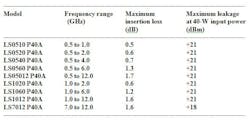In all cases, they are designed to protect a receiver or other sensitive receiver by switching to a high-loss state when impacted by a high-level signal. Different models are usually compared by means of a handful of specifications such as recovery time, spike leakage, limiting threshold, and power-handling capability. For example, the recovery time is the time from the end of an incident RF pulse to where the insertion loss of the limiter returns to a value within 3 dB of the quiescent value.
Spike leakage refers to the characteristic common to limiters to momentarily pass more power than when it is under normal saturated signal conditions. This rise in power is usually a spike on the leading edge of the leakage energy. A limiter’s power-handling capability usually assumes that the limiter is being used in an impedance-matched setup, to minimize the opportunities for standing waves that could reflect energy back through the limiter’s active device and compromise power-handling capability.
Herotek has developed a number of different types of limiters, including the LP Series rated for 1 W CW from 0.5 to 18.0 GHz, the low-limiting-threshold LS Series limiters for 10 MHz to 18 GHz, the low-leakage LL Series for 10 MHz to 18 GHz, and the low-leakage LS Series from 10 MHz to 6 GHz.
The company offers limiters for use at frequencies from 100 kHz (and usable at frequencies as low as 45 kHz) with power-handling capability of 1 W CW and 200 W peak power for short pulses (1-μs pulse width and 0.1% pulse duty cycle). As an example, model LS0000130A covers 100 kHz to 3 GHz with +16 dBm leakage for frequencies below 100 MHz and typically +18 dBm for frequencies below 1 MHz. At higher frequencies, the firm’s model LP1-26A spans 1 to 26 GHz while the model LP26-40A is for 26 to 40 GHz. Both feature typical response time of 10 ns. The former has insertion loss of 4.0 to 4.5 dB with maximum VSWR of 2.0:1, typical limiting threshold of +9 dBm, and leakage of +18 dBm when handling 1 W CW input power.
The firm’s LL Series coaxial limiters are designed for low leakage levels (to -10 dBm), available from 10 MHz to 18 GHz with specified leakage levels of -10, -5, 0, and +5 dBm. These limiters handle 1 W CW and 100 W peak power (for 1 μs) with typical recovery times of less than 10 μs. Depending upon frequency range, the maximum insertion loss varies from 0.5 to 4 dB. The maximum VSWR ranges from 1.30:1 to 2.0:1.
A sampling of 40 W CW frequency range limiter models available.
The firm has also developed higher-power limiters for input levels of 10, 25, and 40 W CW (see table). They share typical limiting thresholds of +6 dBm with typical recovery times of less than 10 μs for power levels to 40 W CW (200 W peak for a 1-μs pulse width). Minimum leakage is +14 dBm for a 1-W input and +21 dBm for a 40-W CW input.
These Herotek limiters incorporate DC blocks at input and output ports. The limiters are supplied in hermetically sealed housings for use in harsh environments. Coaxial models include removable SMA connectors. The firm also offers drop-in and surface-mount versions of some models (see figure). All are built to handle shock levels to 50 g’s for 11 ms and vibration levels to 20 g’s (100 to 2000 Hz). Herotek, 155 Baytech Dr., San Jose, CA 95134; (408) 941-8399, FAX: (408) 941-8388, e-mail: [email protected], www.herotek.com.
About the Author
Jack Browne
Technical Contributor
Jack Browne, Technical Contributor, has worked in technical publishing for over 30 years. He managed the content and production of three technical journals while at the American Institute of Physics, including Medical Physics and the Journal of Vacuum Science & Technology. He has been a Publisher and Editor for Penton Media, started the firm’s Wireless Symposium & Exhibition trade show in 1993, and currently serves as Technical Contributor for that company's Microwaves & RF magazine. Browne, who holds a BS in Mathematics from City College of New York and BA degrees in English and Philosophy from Fordham University, is a member of the IEEE.

